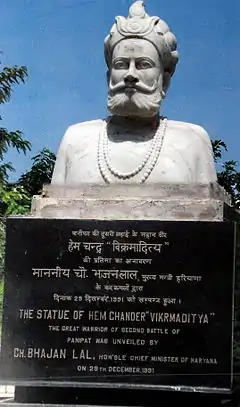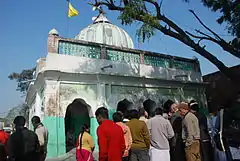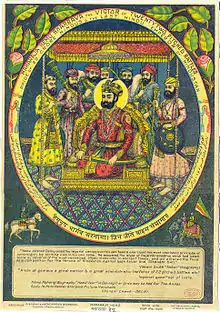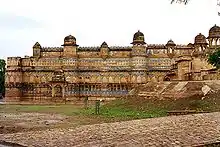Shodapur
Shodapur is a village in Panipat district of the Haryana state in India. The Second Battle of Panipat was fought on 5 November 1556 between the forces of Akbar and Hemu, a Hindu king of Delhi.[1][2] In the battle, a wounded Hemu was captured by Shah Quli Khan and carried to the Mughal camp at Shodapur on Jind Road at Panipat where he was beheaded.
| Shodapur | |
|---|---|
 | |
 Location of Shodapur in Haryana  Shodapur (India) | |
| General information | |
| Coordinates | 29.39°N 76.97°E |
After a few years, Hemu's supporters, constructed a Samadhi (Hindu shrine) over the place where he was beheaded. The place and its surroundings have been slowly encroached upon by the local Muslim people who have converted it into a Muslim durgah. This is the only memorial of Hemu in Panipat but it is in a bad condition.
Gallery
 Hemu's Samadhi Sthal place beheading of Raja Hemu at village Shodapur
Hemu's Samadhi Sthal place beheading of Raja Hemu at village Shodapur Smarat Hemu Bhargava - Victor of Twenty Two Pitched Battles
Smarat Hemu Bhargava - Victor of Twenty Two Pitched Battles Portuguese colonial architecture in Hemu's Haveli in Rewari, which was renovated in 1540, when Hemu became 'Market Superintendent' in Delhi.
Portuguese colonial architecture in Hemu's Haveli in Rewari, which was renovated in 1540, when Hemu became 'Market Superintendent' in Delhi. Agra Fort, won by Hemu in 1553, recaptured from Humayun in 1556, before capturing Delhi.
Agra Fort, won by Hemu in 1553, recaptured from Humayun in 1556, before capturing Delhi. Gwalior Fort, from where Hemu launched most of the attacks during 1553–56, for his 22 battle victories.
Gwalior Fort, from where Hemu launched most of the attacks during 1553–56, for his 22 battle victories.
References
- Richards, John F., ed. (1995) [1993]. The Mughal Empire. The New Cambridge History of India (7th ed.). Cambridge University Press. p. 13. ISBN 9780521566032. Retrieved 29 May 2013.
- Kolff, Dirk H. A. (2002). Naukar, Rajput, and Sepoy: The Ethnohistory of the Military Labour Market of Hindustan, 1450-1850. Cambridge University Press. p. 163. ISBN 9780521523059. Retrieved 29 May 2013.
This article is issued from Wikipedia. The text is licensed under Creative Commons - Attribution - Sharealike. Additional terms may apply for the media files.